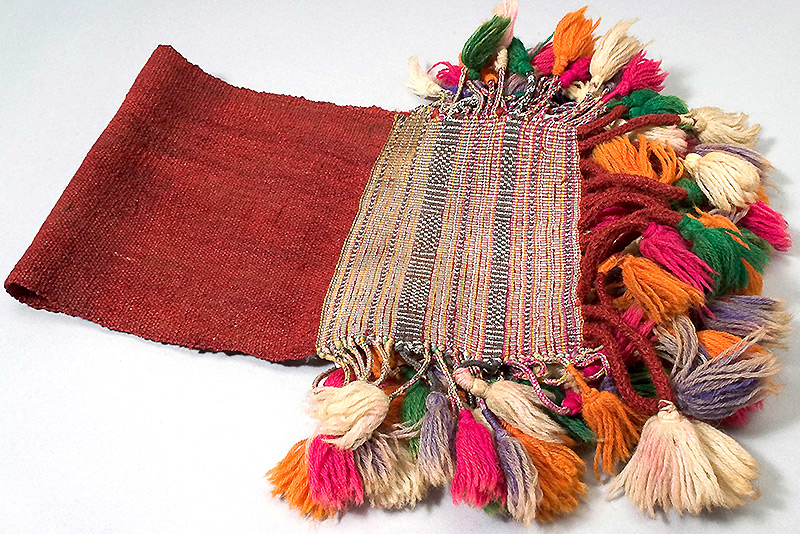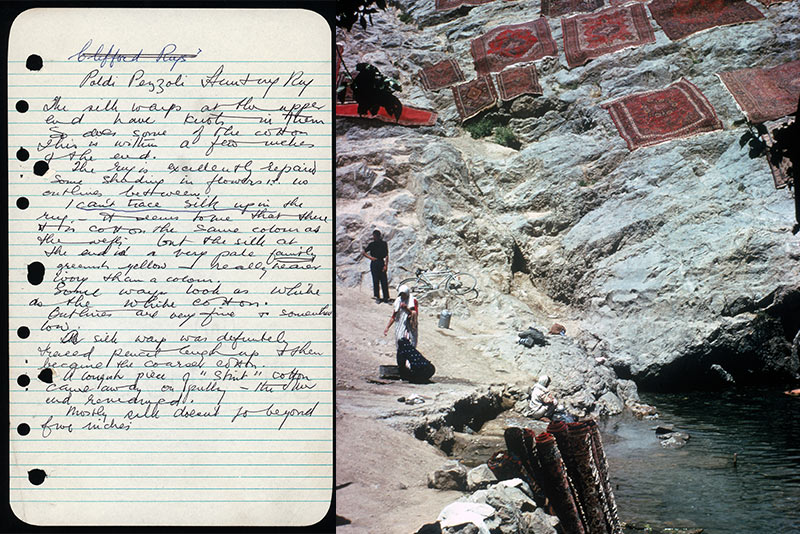Treasured threads
Donor support has enabled Oxford to build one of the world’s most important textile collections. By providing new opportunities for conservation, study and engagement, philanthropy is also the key to helping it thrive.
The Pitt Rivers Museum cares for one of the greatest textile collections in the world, outstanding for its diversity, aesthetic value and technical interest. ‘It’s a collection that shows how people wore textiles and what they wore them for,’ says Julia Nicholson, Curator and Joint Head of Collections at the museum. ‘Not just special pieces, but everyday clothing and textiles too; items with a different kind of value.’
Among the 8,000-strong collection sit Arctic intestine garments, the earliest examples of pre-Columbian textiles from South America, and Maori cloaks that show the first introductions of European materials. Many of the items have been donated or bequeathed by those who spent lifetimes collecting them, such as weaver Gigi Crocker Jones (1933–2002), who acquired an extraordinary assortment of textiles while living in Oman.
‘Being a maker influenced the way that she collected,’ explains Julia, ‘so not only did her bequest include masterpieces of Omani textiles, but also a huge range of items related to the making process, such as looms, spindles and dyes.’ The collection, which is made up of nearly 700 pieces and accompanied by extensive documentation on provenance and function, provides a fascinating insight into the significance of textiles in Omani culture and society.
 Collected by Gigi Crocker Jones in Oman, this camel saddle cloth was used to cover the saddle pad, which is positioned in front of the hump. 2003.9.58 © Pitt Rivers Museum, University of Oxford
Collected by Gigi Crocker Jones in Oman, this camel saddle cloth was used to cover the saddle pad, which is positioned in front of the hump. 2003.9.58 © Pitt Rivers Museum, University of Oxford
Objects such as these have immense value to researchers, students and source communities, but despite this, only 75 items from the museum’s textile collection are fully accessible at present. The rest are consigned to storage, held within a facility not suitable for purpose, and in need of conservation and cataloguing. ‘We have a fantastic conservation team and we know how we should do things, but we don’t always have the resources to do them as well as possible,’ says Julia.
Providing greater access as well as critical conservation and care to this extraordinary collection are just some of the challenges that Oxford is seeking to meet through its new Textiles Study Centre. Projected to open in 2021, the centre will incorporate specialist facilities for textile storage, as well as state-of-the-art conservation and digitisation labs, flexible research and teaching rooms, and additional display space. It is an ambitious project that has already received significant support from The Clothworkers’ Company and the Swire Charitable Trusts, although further funding is currently being sought to realise its full potential.
Once complete, the centre will open up access not only to the Pitt Rivers’ textile collection, but also to that of the Ashmolean Museum, which currently holds some 4,500 items including Pharaonic linen weaving, block-printed Indian medieval trade textiles and medieval Islamic embroideries. ‘It’s an incredible amount of study material,’ says Dr Francesca Leoni, Curator of Islamic Art in the Eastern Art Department, where the bulk of the collection sits.
‘A specialised textile centre as well as expertise are needed, not only to maintain and preserve the collection, but also to interpret it and ideally expand upon it’
As has been the case at the Pitt Rivers, philanthropy has played an important role in building the Ashmolean Museum’s textile collection over the years, with donors gifting items as well as supporting scholarship, digitisation and display. In this respect, for Dr Leoni one bequest is of particular importance: that of May Hamilton Beattie (1908–97), a distinguished scholar in the field of carpet studies.
Established in July 2000, the Beattie Archive comprises a lifetime of research: May Beattie’s library of more than 1,400 books, her collection of predominantly Islamic carpets and weavings, and around 55 notebooks recording her meticulous analysis of carpets in public and private collections around the world. It is this latter element that makes the archive so uniquely significant, and such a valuable resource for scholars and students today.
 Left: May Beattie’s notes on the hunting carpet at the Poldi Pezzoli Museum in Milan, Italy. Right: A photograph captured by Beattie in the 1970s showing carpets drying in the sun in Ray, Iran © Ashmolean Museum, University of Oxford
Left: May Beattie’s notes on the hunting carpet at the Poldi Pezzoli Museum in Milan, Italy. Right: A photograph captured by Beattie in the 1970s showing carpets drying in the sun in Ray, Iran © Ashmolean Museum, University of Oxford
Through her bequest, May Beattie also hoped to establish the foundation of the academic study of carpets at Oxford – something Dr Leoni believes can only be fully realised through the creation of a dedicated centre. ‘It’s funny, we have one of the most important archives of carpets but we don’t really have a carpet collection as such,’ she says. ‘If we had a dedicated centre for textiles, we could also start building up our historic holdings.’
Having a dedicated textile centre as well as textile specialists working within it will also guarantee knowledge about the archive and associated material for the future. ‘It will ensure that this particular body of material is not only maintained but academically framed and disseminated,’ explains Dr Leoni. ‘The centre is the next step towards raising the profile of the archive and carpet studies, and finally realising what May Beattie envisioned.’
The Textiles Study Centre will be located within Reuben College. It will form part of the new Collections Teaching and Research Centre, which will bring substantial areas of the University’s internationally important collections together for the first time.
SUPPORT OXFORD'S MUSEUMS AND COLLECTIONS